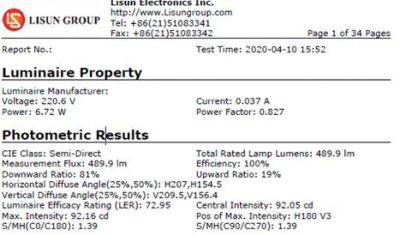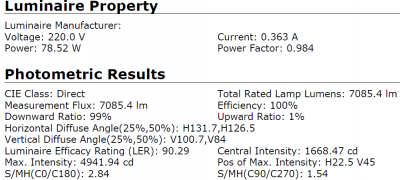According to the provisions of IESNA-LM-79-08, both the integrating sphere system and the goniophotometer can test the luminous flux and color parameters of SSL products. In this experiment, an LED bulb and an integrated street lamp were used to measure the luminous flux in the integrating sphere and goniophotometer, respectively.
 As shown in the figure below, the same bare light source LED bulb was installed in the integrating sphere and Goniophotometer to test.
As shown in the figure below, the same bare light source LED bulb was installed in the integrating sphere and Goniophotometer to test.

Figure 1 Figure 2
The results obtained after testing this naked light source after calibration are as follows:

Figure 3 Integrating sphere system test results

Figure 4 Goniophotometer test results
It can be seen from the results that the luminous flux measured by the integrating sphere is close to the result of the luminous flux test of the goniophotometer, and it can be seen that the integrating sphere has high accuracy in testing the luminous flux of the bare light source. This is because the LED bulb emits light around, which is more suitable for 4π test than other light sources. The integrating sphere uses the standard lamp to calculate the luminous flux and chromaticity parameters of the lamp under test. The luminescence is stable, and the luminous characteristics are similar to the standard lamps, so the test LED bulb lamp data is very close to the test data of the distributed photometer.
Below we use the integrating sphere and goniophotometer to test the luminous flux of the same street lamp to compare the test differences.

The following two figures are the results of two sets of tests

Figure 7 Test results of goniophotometer

Figure 8 Integrating sphere test results
Comparing the above test results, it is not difficult to find that the luminous flux of the integrating sphere test is much lower than that of the goniophotometer test. This is because the street lamp housing is larger, and the lamp itself absorbs the light reflected inside the integrating sphere due to the color of the housing, causing the test results to be biased low,
Due to the self-absorption of lamps, auxiliary lamps are needed to compensate for errors caused by self-absorption when using integrating sphere testing. The following figure shows the test results of street lamps in the integrating sphere after using auxiliary lamps.

Figure 9 Test results using auxiliary lights
After using the auxiliary lamp, the test result of the street lamp in the integrating sphere system is very close to the test result of goniophotometer. This is because the self-absorption coefficient is calculated by the auxiliary lamp, which greatly reduces the error of the integrating sphere test. We have compared the total luminous flux test of the 3-meter electric integrating sphere designed and manufactured by Lisun with the European third-party laboratory, and the results are very close.
It can be seen from the above test comparison that when testing bare light sources such as bulb lamps and other small-sized and stable lamps, the test results of the integrating sphere system and the goniophotometer are similar, but in the test of some small light angles, unstable light For large lamps, it is difficult for the integrating sphere to improve the test results because of the lamp itself, and the error can only be compensated by the auxiliary lamp, while the goniophotometer can make the test results very accurate through its own modulation and operation mode adjustment. .
In summary, for the test of total luminous flux, when testing bare light sources and other small lamps with stable light emission and large light emission angle, an integrating sphere of appropriate size can be selected for testing, because the testing speed of the integrating sphere is relatively fast. When testing large lamps, it is recommended to choose a suitable goniophotometer for testing. If you must use an integrating sphere for testing, you need to buy a sufficiently large integrating sphere and must use auxiliary lights for correction.
Lisun Instruments Limited was found by LISUN GROUP in 2003. LISUN quality system has been strictly certified by ISO9001:2015. As a CIE Membership, LISUN products are designed based on CIE, IEC and other international or national standards. All products passed CE certificate and authenticated by the third party lab.
Our main products are Goniophotometer, Surge Generator, EMC Test Systems, ESD Simulator, EMI Test Receiver, Electrical Safety Tester, Integrating Sphere, Temperature Chamber, Salt Spray Test, Environmental Test Chamber, LED Test Instruments, CFL Test Instruments, Spectroradiometer, Waterproof Test Equipment, Plug and Switch Testing, AC and DC Power Supply.
Please feel free to contact us if you need any support.
Tech Dep: Service@Lisungroup.com, Cell/WhatsApp: +8615317907381
Sales Dep: Sales@Lisungroup.com, Cell/WhatsApp: +8618917996096
Your email address will not be published. Required fields are marked *